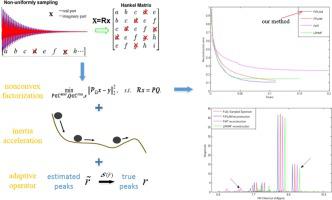Digital Signal Processing ( IF 2.9 ) Pub Date : 2021-07-28 , DOI: 10.1016/j.dsp.2021.103171 Jun Lang 1, 2 , Da Cheng 1

|
Multidimensional nuclear magnetic resonance (NMR) spectroscopy is one of the most powerful tools for qualitative or quantitative analysis of the composition and structure of various organic and inorganic substances. However, the time required to acquire NMR signals increases exponentially with dimensionality. Therefore, non-uniform sampling is commonly adopted to accelerate data acquisition and then the complete spectrum can be obtained by reconstruction method. At present, the state-of-the-art reconstruction methods are based on the idea of low-rank Hankel matrix completion and solved by different singular value thresholding methods. However, the computation of singular value decomposition (SVD) is very time-consuming, especially for high-resolution spectra. In this paper, we proposed a Hankel matrix nonconvex factorization optimization model to avoid SVD, thus greatly reducing the computational time. We developed a numerical algorithm based on the linearized Alternating direction method of multipliers to solve the proposed optimization problem, and Nesterov momentum is adopted to accelerate the convergence of the algorithm. However, for nonconvex model, the high quality reconstruction can only be obtained when the number of the spectral peaks is known. Thus we designed an adaptive strategy to alleviate this problem. Experiments are performed to demonstrate that the proposed algorithm can obtain higher quality reconstruction in less computational time than low rank Hankel matrix factorization and fast iterative hard thresholding methods.
中文翻译:

一种用于非均匀采样核磁共振谱的具有惯性动量的快速汉克尔矩阵非凸分解重建方法
多维核磁共振 (NMR) 光谱是对各种有机和无机物质的组成和结构进行定性或定量分析的最强大的工具之一。然而,获取 NMR 信号所需的时间随维数呈指数增长。因此,通常采用非均匀采样来加速数据采集,然后通过重构方法获得完整的光谱。目前最先进的重建方法都是基于低秩Hankel矩阵补全的思想,通过不同的奇异值阈值方法解决的。然而,奇异值分解(SVD)的计算非常耗时,特别是对于高分辨率光谱。在本文中,我们提出了一种Hankel矩阵非凸分解优化模型来避免SVD,从而大大减少了计算时间。我们开发了一种基于乘法器线性化交替方向法的数值算法来解决所提出的优化问题,并采用 Nesterov 动量来加速算法的收敛。然而,对于非凸模型,只有在谱峰数量已知的情况下才能获得高质量的重建。因此,我们设计了一种自适应策略来缓解这个问题。实验表明,与低秩 Hankel 矩阵分解和快速迭代硬阈值方法相比,所提出的算法可以在更少的计算时间内获得更高质量的重建。我们开发了一种基于乘法器线性化交替方向法的数值算法来解决所提出的优化问题,并采用 Nesterov 动量来加速算法的收敛。然而,对于非凸模型,只有在谱峰数量已知的情况下才能获得高质量的重建。因此,我们设计了一种自适应策略来缓解这个问题。实验表明,与低秩 Hankel 矩阵分解和快速迭代硬阈值方法相比,所提出的算法可以在更少的计算时间内获得更高质量的重建。我们开发了一种基于乘法器线性化交替方向法的数值算法来解决所提出的优化问题,并采用 Nesterov 动量来加速算法的收敛。然而,对于非凸模型,只有在谱峰数量已知的情况下才能获得高质量的重建。因此,我们设计了一种自适应策略来缓解这个问题。实验表明,与低秩 Hankel 矩阵分解和快速迭代硬阈值方法相比,所提出的算法可以在更少的计算时间内获得更高质量的重建。然而,对于非凸模型,只有在谱峰数量已知的情况下才能获得高质量的重建。因此,我们设计了一种自适应策略来缓解这个问题。实验表明,与低秩 Hankel 矩阵分解和快速迭代硬阈值方法相比,所提出的算法可以在更少的计算时间内获得更高质量的重建。然而,对于非凸模型,只有在谱峰数量已知的情况下才能获得高质量的重建。因此,我们设计了一种自适应策略来缓解这个问题。实验表明,与低秩 Hankel 矩阵分解和快速迭代硬阈值方法相比,所提出的算法可以在更少的计算时间内获得更高质量的重建。











































 京公网安备 11010802027423号
京公网安备 11010802027423号